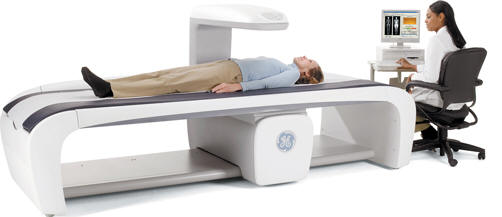FAQs about Bone Mass Density - DEXA
In the United States, over 44 million women and men over 50 are at high risk of developing osteoporosis. Up to 1.5 million fractures a year are attributable to osteoporosis.
Houston MRI® & Diagnostic Imaging's GE Lunar Prodigy offers patients comfort, faster scanning capabilities, and body composition measurement. Our DEXA scanner differs from most traditional scanners because it not only measures the bone density in the lumbar spine and both hips, but also offers detailed body composition analysis which includes fat composition. This is extremely useful in managing disorders or conditions that have affected weight. Testing is fast and the entire DEXA scan takes approximately 10 minutes.

What is Osteoporosis?
Osteoporosis is a disease in which bones become fragile and are more likely to break. If not prevented or if left untreated, osteoporosis can progress painlessly until a bone breaks. These broken bones, also known as fractures, occur typically in the hip, spine, and wrist.
The best way to determine bone density & fracture risk is to have a DEXA scan that accurately measures your Bone Mineral Density (BMD). Diagnosis of osteoporosis can only be made by a physician through a bone density test. We recommend that you show this test to your doctor, who will advise whether further treatement or change in life style is necessary. The good news is that osteoporosis can be diagnosed easily and treated successfully if caught early.
What is a DEXA Scan?
To detect osteoporosis accurately, doctors use an enhanced form of X-ray technology called dual-energy X-ray absorptiometry (DXA or DEXA). DEXA bone densitometry is today's established standard for measuring bone mineral density (BMD). DEXA is a quick, painless procedure for measuring bone loss. Measurement of the lower spine and hips are most often done. More portable devices that measure the wrist, fingers or heel are sometimes used for screening, including some that use ultrasound waves rather than X-rays.
Who should be tested?
- All patients who are concerned with having or developing osteoporosis.
- All postmenopausal women under age 65 who have one or more additional risk factors for osteoporosis.
- All women age 65 and older regardless of additional risk factors, who sustain a fracture.
- All patients who are considering therapy for osteoporosis if bone density testing would facilitate the decision.
- All patients who are or have been on hormone replacement therapy (HRT/ERT) for prolonged periods.
What to expect during the exam?
For a bone densitometry exam, you will lie on your back on the scanning table as scans are taken of your spine and hip. The scan is non-invasive and takes about 10 minutes. Medicare permits individuals to repeat BMD testing every two years.
Is the DEXA exam safe?
In most cases, your radiation exposure will be a fraction of what you would receive from a standard chest X-ray. You may also be interested to know that the radiation exposure is actually about the same, as you would experience on a cross-country airline flight. As with any medical procedure, be sure to inform your physician if you are pregnant.
Click here if you need to know more information about your exam


